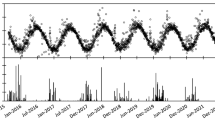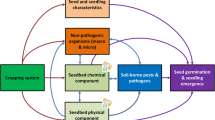Abstract
Water for agriculture is increasingly becoming scarce, and the production of rice will be affected. This necessitates the development of innovative techniques that reduce water input and increase water productivity (WPI+R) of rice. Alternate wetting and drying (AWD) irrigation and use of older seedlings may help reduce the input water requirement of rice. We evaluated the effects of AWD at different threshold levels (irrigation when perched water table drops to 15, 25, or 30 cm below soil surface) in comparison with continuous flooding (CF) and of rice plant seedling ages (S) on grain yield, water input, and WPI+R of lowland rice during the 2010 and 2011 dry seasons. In both years, there was no effect of water management and a significant effect of S. 21-day-old seedlings gave the highest yields. Water savings using AWD ranged from 42.8 to 53.7 % of total water input in comparison with CF, without yield loss, but there was little difference in water input among AWD treatments. Due to shorter duration of growth in the main field, water input with 30-day-old seedlings was lower than with younger seedlings, but with a corresponding yield loss. Total water productivities in AWD treatments were higher than those with CF. Among S, 21-day-old seedlings gave the highest WPI+R and 30-day-old seedlings gave the lowest.






Similar content being viewed by others
References
Belder P, Bouman BAM, Cabangon R, Guoan L, Quilang EJP, Yuanhua L, Spiertz JHJ, Tuong TP (2004) Effect of water-saving irrigation on rice yield and water use in typical lowland conditions in Asia. Agric Water Manage 65:193–210
Belder P, Spiertz JHJ, Bouman BAM, Lu G, Tuong TP (2005) Nitrogen economy and water productivity of lowland rice under water-saving irrigation. Fields Crops Res 93:169–185
Bouman BAM, Tuong TP (2001) Field water management to save water and increase its productivity in irrigated rice. Agric Water Manage 49:11–30
Bouman BAM, Lampayan RM, Tuong TP (2007) Water management in irrigated rice. Coping with water scarcity. Manila, Philippines: International Rice Research Institute. p 53
Bueno CS, Bucourt M, Kobayashi N, Inubushi K, Lafarge T (2010) Water productivity of contrasting rice genotypes grown under water-saving conditions in the tropics and investigation of morphological traits for adaptation. Agric Water Manage 98:241–250
Cabangon RJ, Lu G, Tuong TP, Bouman BAM, Feng Y, Zichuan Z (2003) Irrigation management effects on yield and water productivity of inbred and aerobic rice varieties in Kaefeng. In: Proc. of the 1st International Yellow River Forum on River Basin Management, vol. 2. The Yellow River Conservancy Publishing House, Zhengzhou, pp 65–76
Cabangon RJ, Castillo EG, Tuong TP (2011) Chlorophyll meter-based nitrogen management of rice grown under alternate wetting and drying irrigation. Field Crops Res 121:136–146
Chandra D, Manna GB (1988) Effect of planting date, seedling age, and planting density in late planted wet season rice. Int Rice Res Notes (IRRN) 13(6):30
Dawe D (2005) Increasing water productivity in rice-based systems in Asia-past trends, current problems, and future prospects. Plant Prod Sci 8:221–230
De Datta SK (1981) Principles and practices of rice production. Wiley, Singapore
Faronilo JE, Tuong TP, Lampayan RM, Hosen Y, Bouman BAM, Cabangon RJ, Espiritu AJ, de Dios JL, Soriano JB (2010) Transplanting old seedlings to shorten crop duration in the main field and reduce irrigation water: nursery management effects on crop development. Paper presented at the 28th International Rice Conference, Oct 2010, Hanoi, Vietnam
Furukawa Y (2008) Development of integrated rice cultivation system under water-saving condition. IRRI-Japan Project Annual Report 2008 (unpubl.)
International Rice Research Institute (IRRI) (1997) Rice almanac, 2nd edn. IRRI, Los Baños, p 181
International Rice Research Institute (IRRI) (2007) CropStat for Windows version 7.2. IRRI, Los Baños
Kewat ML, Agrawal SB, Agrawal KK, Sharma RS (2002) Effect of divergent plant spacings and age of seedlings on yield and economics of hybrid rice (Oryza sativa). Indian J Agron 47(3):367–371
Kukal SS, Hira GS, Sidhu AS (2005) Soil matric potential-based irrigation scheduling to rice (Oryza sativa). Irrig Sci 23:153–159
Lampayan RM (2013) Smart water technique for rice. http://www.eiard.org/key-documents/impact-case-studies/2013. Accessed 5 June 2013
Lampayan RM, Bouman BAM, de Dios JL, Lactaoen AT, Espiritu AJ, Norte TM, Quilang EJP, Tabbal DF, Llorca LP, Soriano JB, Corpuz AA, Malasa RB, Vicmudo VR (2003) Adoption of water-saving technologies in rice production in the Philippines. Paper presented at the International Workshop on “Transitions in Agriculture for Enhancing Water Productivity,” Sep 2003, Tamil Nadu, India
Lampayan RM, Bouman BAM, Flor RJ, Palis FG (2013). Developing and disseminating alternate wetting and drying water saving technology in the Philippines. In: Kumar A (ed), Mitigating Water Shortage Challenges in Rice Cultivation: Aerobic and Alternate Wetting and Drying Rice Water Saving Technologies. Asian Development Bank, Manila, Philippines (in press)
Lu J, Ookawa T, Hirasawa T (2000) The effects of irrigation regimes on water use, dry matter production, and physiological responses of paddy rice. Plant Soil 223:207–216
Makarim AK, Blasubramanian V, Zaini Z, Syamsiah I, Diratmadja IGPA, Handoko, Arafah, Warda IP, Gani A (2002) Systems of rice intensification (SRI): evaluation of seedling age and selected components in Indonesia. In: Bouman BAM, Hengsdijk A, Hardy B, Bindraban PS, Tuong TP, Ladha JK (eds) Water-wise rice production. International Rice Research Institute, Los Banos (Philippines), pp 129–138
Mandal BK, Sainik TR, Ray PK (1984) Effect of age of seedling and level of nitrogen on the productivity of rice. Oryza 21:225–232
McDonald AJ, Riha SJ, Duxbury JM, Steenhuis TS, Lauren JG (2006) Water balance and rice growth response to direct seeding, deep tillage, and landscape placement: findings from a valley terrace in Nepal. Field Crops Res 95:367–382
Mishra A, Salokhey VM (2008) Seedling characteristics and the early growth of transplanted rice under different water regimes. Exp Agric 44:1–19
Pasuquin ET, Lafarge T, Tubaña B (2008) Transplanting young seedlings in irrigated rice fields: early and high tiller production enhanced grain yield. Fields Crop Res 105:141–155
Rijsberman FR (2006) Water scarcity: fact or fiction? Agric Water Manage 80:5–22
Samoy KC, Cantre MAC, Corpuz AA, de Dios JL, Sibayan EB, Cruz RT (2008) Controlled irrigation in leaf color chart-based and growth stage-base nitrogen management. In: Proc. of the 38th Annual Scientific Conference of the Crop Science Society of the Philippines, 12–16 May 2008, Iloilo City, Philippines, p 34
Sander BO, Asis CA, Wassmann R (2012). Greenhouse gas emissions from farmers’ rice fields in the Philippines: ‘reality check’ for water management as mitigation option. Poster presented at the International Symposium on Managing Soils for Food Security and Climate Change Adaptation and Mitigation, Vienna, Austria, 23–27 July 2012
Sibayan EB (2011) National dissemination of AWD in the Philippines: experiences and the role of policy support. Paper presented at the International Workshop on “Alternate Wetting and Drying for Resource Conservation and reduction of Environmental Pollution,” Dec 13–14, 2011, Dhaka, Bangladesh
Singh RS, Singh SB (1999) Effect of age of seedlings, N-levels and time of application on growth and yield of rice under irrigated condition. Oryza 36(4):351–354
Sudhir-Yadav Gill E, Humphreys E, Kukal SS, Walia WS (2010) Effect of water management on dry seeded and puddle transplanted rice. Part 1: crop performance. Field Crops Res 120:112–122
Tabbal DF, Bouman BAM, Bhuiyan SI, Sibayan EB, Sattar MA (2002) On-farm strategies for reducing water input in irrigated rice: case studies in the Philippines. Agric Water Manage 56:93–112
Uphoff N (2000) The system of rice intensification developed in Madagascar. Paper presented at the conference on Raising Agricultural Productivity in the Tropics: Biophysical Challenge for Technology and Policy, 16–17 Oct 2000, Harvard University, Cambridge, MA
Vijayakumar M, Ramesh S, Chandrasekaran TM, Thiyagarajan TT (2006) Effect of system of rice intensification (SRI) practices on yield attributes, yield and wáter productivity of rice (Oryza sativa L.). Res J Agric Biol Sci 2(6):236–242
Wiangsamut B (2010) Water-saving method in irrigated rice fields in Tarlac, Philippines. Unpublished PhD thesis, University of the Philippines Los Baños, Laguna, April 2010, p 159
Wopereis MCS, Kropff MJ, Maligaya AR, Tuong TP (1996) Drought-stress responses of two lowland rice cultivars to soil water status. Field Crops Res 46:21–39
Yoshida S (1981) Fundamentals of rice crop science. International Rice Research Institute, Los Baños, p 269
Zhang H, Xue Y, Wang Z, Yang J, Zhang J (2009) An alternate wetting and moderate soil drying regime improves root and shoot growth in rice. Crop Sci 49:2246–2260
Acknowledgments
We wish to thank the Swiss Agency for Development and Cooperation (SDC) through the Water-saving Workgroup of the Irrigated Rice Research Consortium (IRRC) for funding the experiments. We are also grateful to PhilRice management for permission to use the facilities and for the assistance in the conduct of the experiments.
Author information
Authors and Affiliations
Corresponding author
Rights and permissions
About this article
Cite this article
Lampayan, R.M., Samoy-Pascual, K.C., Sibayan, E.B. et al. Effects of alternate wetting and drying (AWD) threshold level and plant seedling age on crop performance, water input, and water productivity of transplanted rice in Central Luzon, Philippines. Paddy Water Environ 13, 215–227 (2015). https://doi.org/10.1007/s10333-014-0423-5
Received:
Revised:
Accepted:
Published:
Issue Date:
DOI: https://doi.org/10.1007/s10333-014-0423-5




